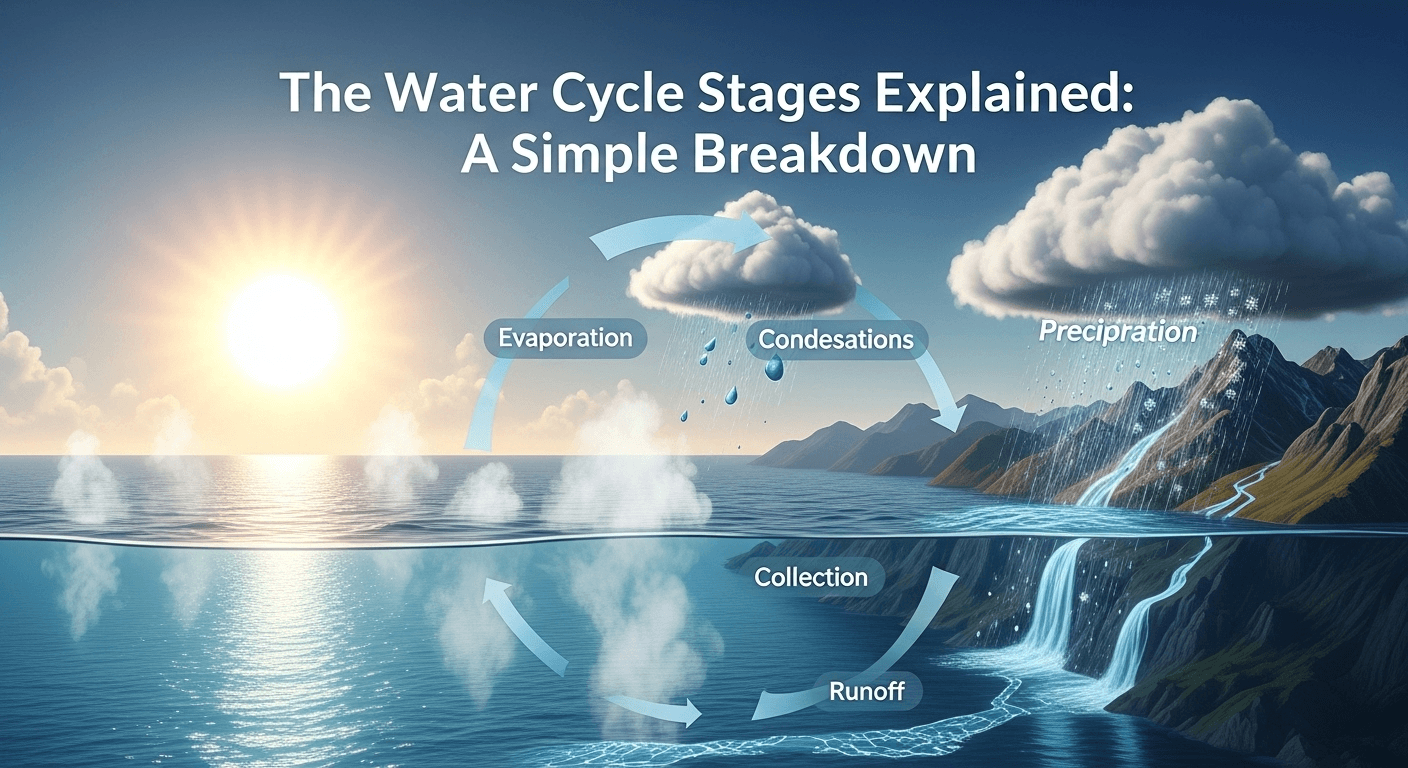Water is the lifeblood of our planet. It covers over 70% of Earth’s surface, makes up about 60% of our bodies, and is essential for every known form of life. But the water you drink today has been on an incredible journey, one that has been repeating for billions of years. This perpetual movement of water on, above, and below the surface of the Earth is known as the water cycle, or the hydrologic cycle. Understanding this process is key to appreciating our planet's most precious resource. In this detailed guide, we will have the stages of the water cycle explained in a simple, easy-to-understand breakdown, exploring each phase of this remarkable natural phenomenon.
Water doesn't just sit still; it's in a constant state of flux, changing form from liquid to gas to solid and back again. This continuous process ensures that water is distributed all over the globe, from the deepest oceans to the highest mountain peaks, and into the atmosphere. The main engine driving this entire system is the sun. Solar energy provides the power needed to lift water vapor into the atmosphere, while gravity is the force that brings it back down to Earth. Without these two fundamental forces, the water cycle would cease to exist, and life as we know it would be impossible.
The beauty of the water cycle lies in its cyclical nature; there is no true start or end. It's a closed loop where water is constantly recycled. However, to understand it better, scientists typically break it down into four main stages: evaporation, condensation, precipitation, and collection. Along the way, other crucial sub-processes like transpiration, infiltration, and runoff play vital roles. In the following sections, we will journey through each of these stages, observing how water transforms and travels across our planet, sustaining ecosystems and shaping our world's climate and geography.
Understanding these stages is more than just a science lesson; it's fundamental to comprehending weather patterns, the availability of fresh water, and the impact of human activities on our environment. From the invisible vapor rising from a lake to the torrential downpour of a thunderstorm, every drop of water is part of this grand, unending voyage. Let's begin our exploration of this fascinating journey.
Table of Contents
ToggleWhat is the Water Cycle and Why is it Essential?
The water cycle, known in scientific terms as the hydrologic cycle, is the continuous circulation of water within the Earth's hydrosphere. This complex system involves the movement of water from the Earth's surface to the atmosphere and back again. It's a colossal purification and distribution network, powered primarily by solar energy. Think of it as Earth’s ultimate recycling program. The total amount of water on our planet has remained relatively constant for billions of years; it’s just constantly changing its form (liquid, gas, solid) and location.
The importance of the water cycle cannot be overstated. It is the foundation upon which all life on Earth depends. Firstly, it is the primary mechanism for distributing fresh water across the planet. Oceans hold over 96% of Earth's water, but it's salty and unusable for most terrestrial life and agriculture. The water cycle, through evaporation, effectively desalinates this water, turning it into fresh water vapor that is then transported over land and delivered as precipitation. This process replenishes rivers, lakes, and groundwater, providing the water essential for drinking, sanitation, and farming.
Furthermore, the water cycle is a key driver of weather and climate. The movement of water and heat around the globe influences temperature, air pressure, and wind patterns. Evaporation cools surfaces, while condensation releases heat into the atmosphere, impacting atmospheric stability and driving storms. The formation of clouds affects the amount of sunlight reaching the Earth's surface, playing a crucial role in regulating the planet's temperature. In essence, without the constant churning of the water cycle, our planet's climate would be drastically different and far less hospitable.
The Upward Journey: Evaporation and Transpiration
The first major phase in our journey through the water cycle involves water moving from the Earth's surface up into the atmosphere. This upward movement is primarily achieved through two key processes: evaporation and transpiration. Both involve the transformation of liquid water into water vapor (a gas), but they occur through different pathways. This phase is entirely dependent on energy from the sun. The sun's heat provides the kinetic energy needed for water molecules to break their bonds and escape into the air as an invisible gas.
This atmospheric moisture is the raw material for clouds and, eventually, precipitation. While oceans, seas, lakes, and rivers are the largest sources of evaporation, this process happens from any wet surface, including damp soil and even a puddle on the pavement after a rain shower. Combined, evaporation and transpiration are responsible for moving vast quantities of water into the atmosphere every single day, fueling the entire climatic engine.
Scientists often use the term evapotranspiration to refer to the sum of water loss from a given area, combining both evaporation from the land surface and transpiration from plants. This combined process is a critical component of water balance calculations for a watershed or ecosystem, helping us understand how much water is available for other uses versus how much is returned to the atmosphere.
Evaporation: Water's Great Escape
Evaporation is the process where a liquid turns into a gas. In the context of the water cycle, it's how water from oceans, lakes, rivers, and other bodies of water enters the atmosphere as water vapor. The sun's energy heats the surface of the water, increasing the energy of the water molecules. When a molecule gains enough energy, it can break free from the liquid's surface and escape into the surrounding air. This is a constant and silent process, happening all the time, all over the world. Approximately 90% of the moisture in the atmosphere comes directly from evaporation.
Several factors influence the rate of evaporation. Temperature is the most obvious one; warmer water evaporates faster. Humidity also plays a big role; evaporation is slower in humid air because the air is already saturated with water vapor. Wind speed is another factor; wind can move moist air away from the water's surface, replacing it with drier air and thus speeding up evaporation. Finally, the surface area of the water body matters; a wide, shallow lake will have a higher rate of evaporation than a deep, narrow one with the same volume of water.
Transpiration: The Plant-Powered Pump
Transpiration is essentially the plant equivalent of evaporation. It is the process where plants absorb water through their roots and then release it as water vapor through small pores on the underside of their leaves, called stomata. While a single plant may not seem to release much water, the cumulative effect of billions of plants, especially in large forests, is enormous. A large oak tree, for instance, can transpire up to 40,000 gallons of water into the atmosphere in a single year. Transpiration accounts for about 10% of the moisture in the atmosphere.
This process is a vital part of a plant's life. It helps pull water and nutrients from the soil up to the leaves for photosynthesis and also serves to cool the plant, much like sweating cools the human body. The rate of transpiration is influenced by the same factors as evaporation—temperature, humidity, and wind—as well as light intensity. Areas with dense vegetation, like the Amazon rainforest, contribute so much water vapor to the atmosphere through transpiration that they can essentially create their own weather systems and rainfall.
The Sky-High Transformation: Condensation and Cloud Formation
Once water vapor enters the atmosphere through evaporation and transpiration, the next stage of the cycle begins: condensation. As warm, moist air rises, it expands and cools due to lower atmospheric pressure at higher altitudes. This cooler air has a reduced capacity to hold water vapor. When the air cools to its dew point temperature, the water vapor begins to change its state from a gas back into a liquid, forming tiny water droplets or ice crystals. This process is the direct opposite of evaporation.
These minuscule droplets are so light that they can remain suspended in the air. For condensation to occur, the water vapor needs a surface to condense onto. In the atmosphere, these surfaces are provided by microscopic particles known as cloud condensation nuclei (CCN). These can be tiny specks of dust, salt from ocean spray, pollen, volcanic ash, or pollutants. Without these particles, clouds would have a much harder time forming, even in saturated air.
The release of latent heat during condensation is a critical aspect of this stage. When water vapor condenses into liquid water, it releases the same amount of energy that was required to evaporate it in the first place. This release of heat warms the surrounding air, making it more buoyant and causing it to rise further. This process is a major source of energy for atmospheric phenomena, including thunderstorms and hurricanes, making condensation a powerful engine for weather.
The Mechanics of Condensation
You can see condensation happen right in front of you. When you take a cold can of soda out of the refrigerator on a humid day, its outer surface quickly becomes covered in water droplets. This isn't the can "leaking"; it's water vapor from the surrounding air cooling down as it comes into contact with the cold surface, condensing into liquid water. The same principle applies in the atmosphere, just on a much grander scale.
As air rises, it cools at a predictable rate. Eventually, it reaches a temperature at which it can no longer hold all of its water vapor. At this point, the air is said to be saturated. The water vapor then condenses into billions of tiny liquid water droplets, each one formed around a condensation nucleus. If the temperature is cold enough (below freezing, 0°C or 32°F), the water vapor can deposit directly into tiny ice crystals instead of liquid droplets.
From Droplets to Clouds
A cloud is nothing more than a visible mass of these tiny water droplets or ice crystals suspended in the atmosphere. It's the visual manifestation of condensation. As more and more water vapor condenses, these droplets accumulate and form the clouds we see in the sky. The type of cloud that forms depends on factors like atmospheric stability, altitude, and temperature.
Different clouds signify different weather conditions. For example, puffy cumulus clouds are often associated with fair weather, but can grow into towering cumulonimbus clouds that produce thunderstorms. Flat, layered stratus clouds often bring overcast skies and light drizzle. Wispy, high-altitude cirrus clouds are made of ice crystals and usually indicate fair weather, but can sometimes signal an approaching change in the weather. The formation of clouds is the essential precursor to the next major stage of the water cycle: precipitation.
The Return to Earth: Precipitation in its Many Forms
After water vapor has condensed to form clouds, the water is still suspended high in the atmosphere. The next step in the cycle is for this water to return to the Earth's surface. This process is known as precipitation. It occurs when the tiny water droplets or ice crystals within clouds grow large and heavy enough that air currents can no longer support them, and gravity pulls them down to the ground. Precipitation is the primary way that water is delivered from the atmosphere back to the planet.

For precipitation to happen, the cloud droplets must grow significantly in size. A typical cloud droplet is about 100 times smaller than a raindrop. This growth occurs through two main processes. The first is collision-coalescence, which happens in warmer clouds where droplets collide and merge to form larger drops. The second is the Bergeron process, which occurs in colder clouds containing a mixture of supercooled water droplets and ice crystals. The ice crystals grow at the expense of the water droplets until they are heavy enough to fall.
The form that precipitation takes—rain, snow, sleet, or hail—is determined by the temperature profile of the atmosphere it falls through. This is why you can have rain in one area and snow just a few miles away at a higher elevation. The global distribution of precipitation is highly uneven, with some regions like tropical rainforests receiving daily downpours, while deserts may go years without significant rainfall. This distribution is a direct result of global wind patterns and geography.
Rain, Snow, Sleet, and Hail
The most common forms of precipitation are easily distinguished by the atmospheric conditions they form and fall through.
- Rain: This is liquid precipitation. It starts as either ice crystals or liquid droplets in a cloud but melts on its way down if it falls through air that is above the freezing point (0°C or 32°F).
- Snow: This is precipitation in the form of ice crystals, or snowflakes. For snow to reach the ground, the temperature must be at or below freezing all the way from the cloud to the surface.
- Sleet: Sleet consists of ice pellets. It occurs when snowflakes fall from a cloud, pass through a warm layer of air and melt into raindrops, and then fall through a final deep layer of freezing air near the ground, causing them to re-freeze into pellets of ice.
- Hail: Hail consists of solid, layered balls of ice. It is formed exclusively in strong thunderstorms with powerful updrafts. Raindrops are carried upward by the storm's updraft into extremely cold areas of the atmosphere, where they freeze. They fall, collect more water, and are swept back up to freeze again, adding another layer of ice. This process repeats until the hailstone is too heavy for the updraft to support, and it falls to the ground.
The Final Leg: Collection, Runoff, and Infiltration
Once precipitation reaches the Earth's surface, the final stage of the water cycle, collection, begins. This is where the water gathers before its journey potentially starts all over again with evaporation. The water can be collected in various ways, and its path is determined by geography, topography, soil type, and land use. The two primary pathways for collected water are surface runoff and infiltration into the ground.
This stage is crucial for replenishing the Earth's water reservoirs. Water that collects in rivers and lakes provides habitats for aquatic life and resources for human use. The water that soaks into the ground becomes a vast, hidden reservoir of fresh water that sustains plant life and can be tapped by wells. Eventually, all of this water—whether on the surface or underground—is on a journey back toward the oceans, where the majority of the planet's water is stored and where the cycle of evaporation is most prominent.
The balance between runoff and infiltration is delicate and can be easily disrupted by human activity. Urbanization, for example, with its vast expanses of impervious surfaces like concrete and asphalt, dramatically reduces infiltration and increases surface runoff. This can lead to decreased groundwater recharge and an increased risk of flash flooding in urban areas.
Surface Runoff: The Water Superhighway
When precipitation falls on land, particularly during heavy rain or snowmelt, some of it flows over the surface. This is known as surface runoff. This water naturally flows from higher elevations to lower elevations due to gravity. It begins as a thin sheet of water (sheet flow) before concentrating into small channels called rills, which then merge to form gullies, streams, and eventually large rivers. These rivers act as superhighways, transporting water across the land and ultimately carrying it back to lakes or the ocean.
The amount of runoff is influenced by several factors. Steep terrain leads to faster and greater runoff. Rocky or clay-rich soils, which are less permeable, also promote more runoff. Perhaps the most significant factor in modern times is land use. Paved surfaces in cities and towns are almost 100% impervious, meaning nearly all rainfall becomes immediate runoff. In contrast, a healthy forest floor acts like a sponge, absorbing a large portion of rainfall and reducing runoff significantly. This is why deforestation and urbanization can drastically alter local hydrology.
Infiltration and Groundwater: The Hidden Reservoir
Not all water that precipitates becomes runoff. A significant portion soaks into the ground in a process called infiltration. This water seeps down through soil and porous rock, filling the cracks and spaces between particles. This water is known as groundwater. The area underground where the soil is completely saturated with water is called the saturated zone, and the upper level of this zone is the water table.
Groundwater is an incredibly important resource. It is the largest reservoir of liquid fresh water on Earth, far exceeding the amount in all lakes and rivers combined. This hidden water moves very slowly, sometimes only a few meters per year, through underground layers of water-bearing rock called aquifers. Groundwater can eventually re-emerge at the surface through springs, or it can seep into rivers and lakes, helping to maintain their flow during dry periods. It is also the primary source of drinking water for a large portion of the world's population, accessed through wells.
—
Comparison of the Main Water Cycle Stages
| Stage | Process | State Change | Primary Driver(s) |
|---|---|---|---|
| Evaporation | Water turns from liquid to gas and rises into the atmosphere. | Liquid to Gas | Solar Energy |
| Condensation | Water vapor cools and turns back into liquid droplets, forming clouds. | Gas to Liquid | Cooling Air/Altitude |
| Precipitation | Water falls from clouds back to Earth's surface. | Liquid/Solid | Gravity |
| Collection | Water gathers on the surface (runoff) or underground (infiltration). | N/A | Gravity, Topography |
—
Frequently Asked Questions (FAQ)
Q1: What is the main driver of the water cycle?
A1: The primary driving force behind the entire water cycle is energy from the sun. Solar radiation provides the energy needed for evaporation, which lifts water from the surface into the atmosphere. Gravity is the other key force, responsible for pulling water back down to Earth in the form of precipitation.
Q2: How long does a single water molecule spend in one part of the cycle?
A2: The residence time of a water molecule varies dramatically depending on where it is. A molecule might spend only about 9-10 days in the atmosphere before falling as rain. In a fast-flowing river, it might take a few weeks to reach the ocean. However, a water molecule could be locked in a polar ice cap for thousands of years, or spend centuries deep within a groundwater aquifer.
Q3: Can we ever run out of water on Earth?
A3: No, we cannot "run out" of water in the sense that the total amount of water on Earth is constant and is continuously recycled. However, we can and do face shortages of clean, fresh, and accessible water. Pollution can render water unusable, and climate change can alter precipitation patterns, causing severe droughts in some regions and intense floods in others. So, while the water itself doesn't disappear, its availability for human and ecosystem needs can be severely threatened.
Q4: What is evapotranspiration?
A4: Evapotranspiration is a combined term used by scientists to describe the total transfer of water from the Earth's land surface to the atmosphere. It is the sum of water lost through evaporation (from soil and water surfaces) and transpiration (from plants). It's a convenient and important metric for understanding the water balance of an ecosystem or region.
Conclusion
The water cycle is an elegant and powerful system, a continuous dance between the Earth and atmosphere driven by the sun and gravity. From the invisible rise of vapor from a sun-drenched ocean to the formation of majestic clouds, the life-giving fall of rain, and the slow, patient journey of groundwater, every stage is interconnected and indispensable. This cycle is not just a scientific concept; it is the fundamental process that shapes our planet’s landscapes, dictates our weather, and sustains all life.
Having the stages of the water cycle explained reveals a process of immense scale and complexity, yet one with a simple, unifying purpose: to circulate and purify Earth's most vital resource. As our global population grows and our climate changes, the pressures on this cycle are increasing. Understanding its mechanics is the first step toward responsible stewardship. By protecting our forests, managing our water resources wisely, and mitigating our impact on the climate, we can help ensure that this incredible journey of water continues to support a healthy and vibrant planet for generations to come.
***
Summary
This article provides a comprehensive and SEO-optimized explanation of the water cycle, a fundamental process for life on Earth. Titled "The Water Cycle Stages Explained: A Simple Breakdown," it details the continuous journey of water as it moves on, above, and below the Earth's surface. The cycle is driven by solar energy, which powers evaporation, and gravity, which brings water back down as precipitation.
The article breaks down the cycle into its key stages. It begins with the upward journey, covering Evaporation (liquid water turning to gas from oceans and lakes) and Transpiration (water vapor released by plants). Next, it explores the sky-high transformation phase, explaining Condensation (water vapor cooling to form liquid droplets) and the subsequent Cloud Formation. The return to Earth is detailed through Precipitation, discussing its various forms like rain, snow, sleet, and hail. Finally, the article covers the collection phase, where water either becomes Surface Runoff into rivers and oceans or Infiltration, seeping into the ground to become groundwater. A comparative table, a detailed FAQ section, and a discussion on the importance of each stage are included to provide a complete and engaging educational resource.















